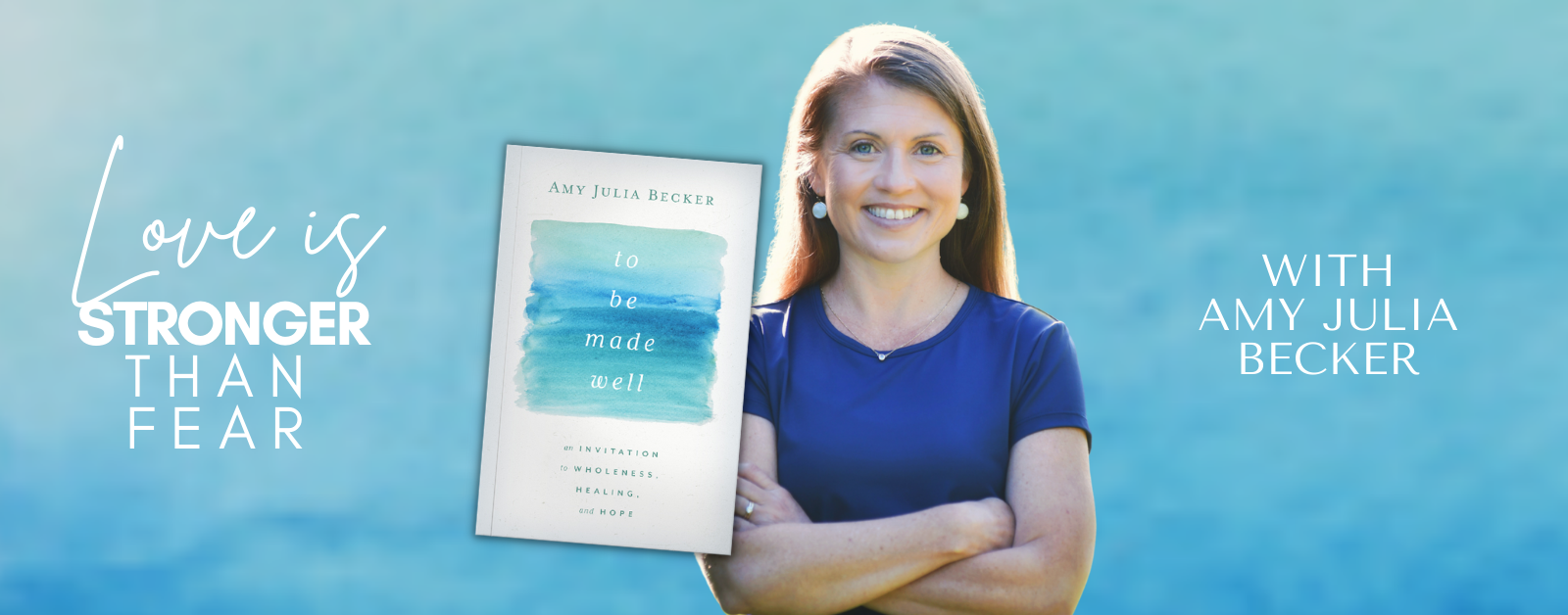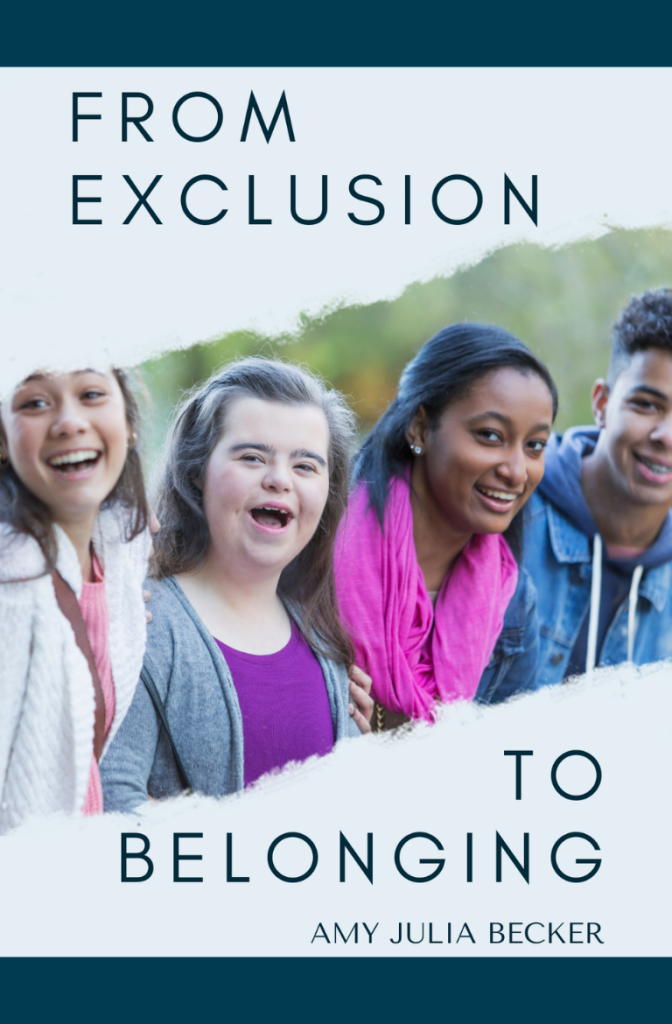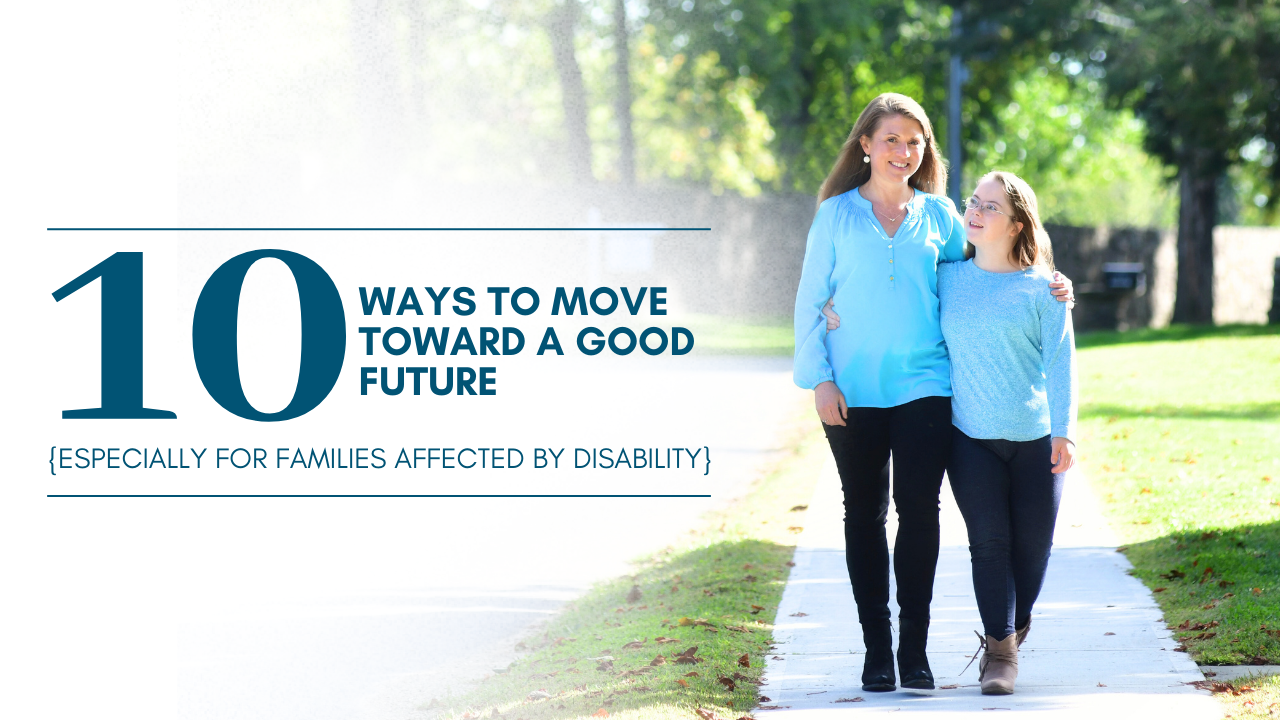For anyone struggling with pain or loss, for anyone concerned about the things that divide us, this episode—this book— is for you. It’s launch day for my latest book, To Be Made Well. I’m celebrating by sharing an excerpt with you! I hope you enjoy it, and if you think of other people who might find this relevant and helpful in their own lives, please pass it along to them as well.
You can find more info about To Be Made Well here.
“From hurting bodies and souls to hurting relationships and communities, it’s clear that things are not as they should be. The gospels brim with stories of Jesus healing people, but what does that mean for us today? In To Be Made Well, author Amy Julia Becker weaves together her own story with reflections on biblical accounts of Jesus’ healing work, providing fresh insight into both the nature of healing and the pathway to healing, then and now. This book is a powerful invitation to personal, spiritual, and social healing as we reconnect to our bodies and souls, to God, and to our communities.
For anyone struggling with pain or loss, for anyone concerned about the things that divide us, this book goes beyond wellness and beyond miraculous physical transformations to explore how we can—personally and collectively—be made well.”
___
Recording is from To Be Made Well: An Invitation to Wholeness, Healing, and Hope by Amy Julia Becker. Used by permission of Herald Press. All rights reserved.
Note: This transcript is autogenerated using speech recognition software and does contain errors. Please check the corresponding audio before quoting in print.
1 (5s):
Hi friends. I’m Amy Julia Becker. And this is love is stronger than fear. A podcast about pursuing hope and healing in the midst of personal pain and social division. Today’s episode is a special episode. This is a bonus because today is the day. My new book releases. You’ve been hearing about this for a long time. If you’ve been paying attention on this podcast, but I can tell you I’m so excited to be made well is officially available. Wherever books are sold. And this is a bonus episode because if you are a listener, you’ll know that every other week I release an interview with someone. And this is one of those off weeks where you’re supposed to just catch up on listening to the interview from last week, but instead to celebrate the release of, To Be Made Well, I wanted to share an audio version of the excerpt from the book that is available on my website.
1 (58s):
So I am going to read you the introduction to, to be made well, and I hope this will give you a feel of what the book is all about. I also hope you’ll enjoy it. And if you do think of people who might find this relevant and helpful in their own lives, I ask that you might please pass it along to them to help me celebrate as this goes out into the world. All right, you’ll probably hear some rustling of pages because I’m just sitting here in front of my computer in a couple of weeks, I’m going to get to record the audio book and a much more official way, which is very exciting. But here I am just looking out the window with my little microphone, plugged into my little computer and my paperback copy of the book in front of me.
1 (1m 40s):
So, you know, if you hear some background noise, you’ll just feel like you’re in the room with me. While I read out loud from my book here we are introduction. I started throwing up when I was 14 years old. It began on a Friday night in December, a few hours after our family of six, enjoyed a special dinner in the restaurant of a local hotel. The lobby looked festive with white lights and greenery and holiday music in the background. A magician moved from table to table, hiding coins and pulling scarves out of unexpected crevices. My little sisters giggled with delight. It came time to order dinner and I faced a decision.
1 (2m 21s):
I hadn’t eaten a full meal in weeks earlier that fall, I had vowed to limit myself to 1000 calories per day. I wrote this goal in my journal and signed it a pledge to myself and to the gods of thinness. I had just come home from fall term at a boarding school. So my mother wasn’t aware of my dramatic shift in eating. She would have registered concern about my new diet of apples, frozen yogurt, bagels, and salad. That night I broke my pledge. I ordered fajitas and an ice cream sundae. I wanted the pretense of normalcy. I didn’t want my family to notice that anything had changed.
1 (3m 5s):
The food tasted sumptuous, but I worried about what the scale would tell me in the morning. Once we returned to our house, I decided to balance out the meal by riding the stationary bike in our attic. My dad worked out twice a day. So even at the odd hour of nine at night, no one in my family thought much about my decision to exercise. The surprise came just before I got in the shower. When I threw up, I didn’t feel nauseated. I didn’t gag. It was more like a polite, unexpected, not even entirely unpleasant regurgitation. I mentioned it with a shrug to my mom the next morning, but then it happened again the next night and the next, within a few weeks I was in voluntarily regurgitating, everything that went into my body in February.
1 (3m 56s):
I was admitted to the hospital for observation. The plan was to feed me scrambled eggs with radioactive particles, and then watch those eggs move through my digestive track. But the eggs didn’t move. They sat in my gut. Your stomach walls looked gray. My gastroenterologist said like the stomach of a 90 year old, the technical diagnosis was gastro-paresis. My stomach was paralyzed. Identifying the cause of the problem. Didn’t make a difference. I couldn’t keep down any food. I was losing weight. I took medication to improve motility, but it didn’t help. After a year of painful blood draws and tests and tubes that never amounted to much change in my condition.
1 (4m 40s):
We tried acupuncture and biofeedback. I tried a diet restricted to simple soft foods. I tried drinking only ensure or tried prayer members of our church gathered around me, prayed for healing and anointed me with oil and surely pray an elder whose spiritual gifts to fit. Her name said to me gently after the anointing, this one will take a long time. I went on and off intravenous fluids in and out of the hospital became familiar with fainting from rising too fast. Those early months turned into five years of struggle. Part of me wanted to get better, but mostly I felt relieved that I could eat without fear of what the scale would report and relieved that I couldn’t be blamed for.
1 (5m 27s):
Self-harm. I had friends with anorexia and bulimia who were in and out of treatment centers and therapist offices, but I could tell myself and my parents and teachers and doctors that my body was inexplicably malfunctioning, and I simply needed a medical cure. Looking back decades later, I vacillate between calling this illness and eating disorder and accepting the medical diagnosis of gastroparesis. I can see my unhealthy mindset around food, but my body was also clearly impaired. I still don’t have the words to combine the bodily and psychological reality, pulling the threads of the physical and the emotional aspects of my situation.
1 (6m 10s):
Only results in a tighter, not even now. When I think of how often as an adult, I’ve succumbed to illness in a time of stress, or when I think of friends lying in bed from migraines while managing the pressure of childcare and working at home during a pandemic, or when I read about the increase in debilitating back pain and substance use disorders and anxiety in our modern era, I see in myself and in our culture, an inability to connect to the physical, emotional, spiritual, and social aspects of who we are. I mean, I like many others feel a longing for that connection or longing for healing two years into my illness, my boyfriend at the time.
1 (6m 53s):
And now my husband confronted me. He had noticed how I excused myself from every meal. He noticed my dry, brittle hair and skinny limbs. He noticed my evasive answers to questions about food. He asked me to count how often I threw up in a day. The next night I told him eight times Peter insisted I needed help. And I was both ashamed and relieved to agree with him this time. I felt certain that the answers would come from uncovering my emotions around food and my body. So I went to therapy. I met with a nutritionist. I ate as she instructed and I gained 20 pounds over the course of a few months.
1 (7m 37s):
Until one day I broke. I returned to the familiar pattern. Soon thereafter, I found myself in the emergency room routine blood work indicated my heart was in danger of stopping. I was 17 years old as I saw it. The doctors had failed me therapy and nutritionists had failed. Me and prayer had failed me. I had wanted God to swoop in and offer an immediate and miraculous change to my body. And that didn’t happen. All I had left was myself, four years in, I set a goal of only throwing up twice each day. Then a goal of once a day.
1 (8m 18s):
Then once every other day it was miserable. I hated the changes to my body. I hated the sensation of forcing food into my stomach, but I also wanted to get well. I started to take small steps that seem to actually make a difference. I stopped buying magazines like self and shape and glamour with images of women in bathing suits and promises of the next great food or exercise fat on their covers. I memorized Bible verses about how God cares about our hearts and not about the way our bodies look. And I started to receive physical therapy for my stomach. Once a week, I lay on a table, passive, receptive, and talked as Kim, the physical therapist pressed on my abdomen and needed my paralyzed organs back to life.
1 (9m 6s):
She asked basic questions like what’s your favorite food? When I talked about how much I loved French fries, my stomach audibly gurgled as if the prospect of that nourishment and pleasure demanded a bodily response. For years, I had carefully separated the physical and mental aspects of my being, but telling Kim simple stories about my parents, my sisters, my boyfriend, my school combined with her gentle massage seemed to knit me back together. I could feel my stomach wake up over the course of a few months of weekly sessions. I finally began to get, well, I didn’t have the language for it at the time, but I was learning that our modern medical system as marvelous and innovative as it is, has tremendous limits when it comes to healing.
1 (9m 59s):
I recognized this disconnect again in my mid twenties, when my mother-in-law was diagnosed with cancer and doctors could recommend treatments, but didn’t know how to offer care. As she faced the reality of a terminal illness, I ran into it when our oldest daughter was diagnosed with down syndrome and received labels of defective and abnormal as if who she was as a person could be reduced to a category called DISABILITY. I saw it again in my thirties when my back began to hurt. And I couldn’t explain where the pain came from. And I needed this understanding when our nation entered a global pandemic in a time of racial reckoning, when a biomedical approach to healing was not enough to care for our wounded souls on our divided society.
1 (10m 47s):
Most people do not have such an extreme story of illness and disorder at such a young age, but all of us have been taught to isolate our bodies from our minds and our spirits. Many of us have physical ailments that stem from stress or heartache, whether it’s the minor affliction of a cold sore on a lip or the major disruption of a chronic condition. And even when we do not carry our emotional pain within our own bodies, our bodies nevertheless, feel the pain and division of the world around us. We live in a society that assumes our personal and collective pain can be addressed through biomedical fixes for Christians and other people of faith.
1 (11m 28s):
We often hope for our own version of a fixed through miraculous intervention. Sometimes surgeons or prayer can instigate immediate physical changes in our bodies, but even then, and especially when we wait and wait and wait without any change arriving, we are in need of a more comprehensive healing. As much as modern medicine can play a crucial role in our lives. It is nevertheless not enough to restore us individually or collectively to health. We need a broader and deeper understanding of healing in order to be made. Well, this book is an exploration of this type of healing, comprehensive, personal spiritual, and communal restoration to a life-giving relationship with God, looking at stories about Jesus and especially the story of a synagogue leader and a bleeding woman in Mark’s gospel.
1 (12m 26s):
Part one addresses the nature of Jesus’s healing. This healing is for our whole selves, mind, body, and spirit. This healing is an invitation for each of us and all of us to know God’s love personally, this healing is also a call to be received by and restored to community part two considers how distraction, shame, anxiety, and injustice can keep us from healing and part three Explorer’s ways. We are all invited to receive God’s healing love just as we are all invited to participate in extending that abundant love towards others.
1 (13m 6s):
My own longing for healing and wholeness began when I couldn’t figure out a way to piece my body and soul together. When doctors alternative medicine therapists and my own willpower didn’t have the answers within all that confusion. I did turn to God, I didn’t receive a quick fix, but I did receive a sense of God’s presence. God was with me, even if my prayers weren’t answered the way I thought they should be. I’ve now walked alongside others on their own journeys toward wholeness. And I have seen how healing can happen even in the midst of ongoing pain and unanswered questions. I now wonder whether God’s refusal to cure my illness with a quick miracle was in and of itself an invitation to a deeper work of healing.
1 (13m 56s):
I emerged from those years of illness with a better understanding of how my body and mind and emotions were interrelated with a deeper faith and with a greater sense of purpose in the world. I was like the blind man healed by Jesus in John’s gospel. 2000 years later, I echoed his words. I don’t know who it was, who healed me. I just know I once was blind. And now I see Thanks as always for listening to this special bonus. Episode of Love Is Stronger Than Fear. And thanks for taking the time to celebrate the release of, To Be Made Well with me, I will be recording that book on audio in the coming weeks.
1 (14m 41s):
I’ll let you know when it’s available in full in that format, but for now you can find it online. You can request it at your local bookstore, look for it in a local library, access it through Kindle. I will be back next week on the podcast for a more typical conversation this time with Katherine Wolf, who is an author speaker and the co-founder of hope heals and who also wrote the forward to, To Be Made Well as always, I’m grateful to Jake Hansen for editing this podcast and to Amber Beery, my social media coordinator. And I’m thankful to you, the listener as you go into your day to day, I hope you will carry with you. The peace that comes from believing that Love Is Stronger Than Fear.




